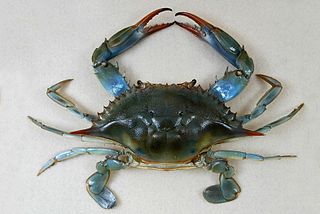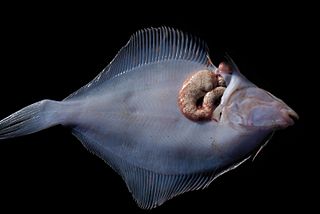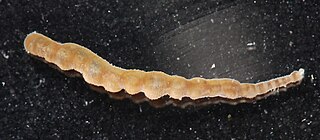Related Research Articles

Callinectes sapidus, the blue crab, Atlantic blue crab, or, reigonally, the Maryland blue crab, is a species of crab native to the waters of the western Atlantic Ocean and the Gulf of Mexico, and introduced internationally.
Perkinsus is a genus of alveolates in the phylum Perkinsozoa. The genus was erected in 1978 to better treat its type species, Perkinsus marinus, known formerly as Dermocystidium marinum. These are parasitic protozoans that infect molluscs, at least some of which cause disease and mass mortality. P. marinus is the most notorious, causing the disease perkinsosis, or dermo, in wild and farmed oysters.

Sea lice are copepods of the family Caligidae within the order Siphonostomatoida. They are marine ectoparasites that feed on the mucus, epidermal tissue, and blood of host fish. The roughly 559 species in 37 genera include around 162 Lepeophtheirus and 268 Caligus species.

A xenoma is a growth caused by various protists and fungi, most notably microsporidia. It can occur on numerous organisms; however is predominantly found on fish.
Paramoeba is a genus of common parasites, including species that can cause infection in fish, crabs, sea urchins and others.

Profilicollis is a genus of acanthocephalan parasites of crustaceans. The status of the genus Profilicollis has been debated, and species placed in this genus were formerly included in the genus Polymorphus. However, research on the morphology of the group and their use of hosts has concluded that Profilicollis and Polymorphus should be regarded as distinct genera, and species previously described as Polymorphus altmani are now referred to as Profilicollis altmani in taxonomic and biological literature. Profilicollis parasites infect decapod crustaceans, usually shore crabs, as intermediate hosts, and use many species of shorebirds as definitive (final) hosts.
Marteilia is a protozoan genus of organisms that are parasites of bivalves. It causes QX disease in Sydney rock oysters and Aber disease in European flat oysters. After being infected by Marteilia, bivalves lose pigmentation in their visceral tissue, and become emaciated.

Like humans and other animals, fish suffer from diseases and parasites. Fish defences against disease are specific and non-specific. Non-specific defences include skin and scales, as well as the mucus layer secreted by the epidermis that traps microorganisms and inhibits their growth. If pathogens breach these defences, fish can develop inflammatory responses that increase the flow of blood to infected areas and deliver white blood cells that attempt to destroy the pathogens.
Hematodinium is a genus of dinoflagellates. Species in this genus, such as Hematodinium perezi, the type species, are internal parasites of the hemolymph of crustaceans such as the Atlantic blue crab and Norway lobster. Species in the genus are economically damaging to commercial crab fisheries, including causing bitter crab disease in the large Tanner or snow crab fisheries of the Bering Sea.
Amoebophyra is a genus of dinoflagellates. Amoebophyra is a syndinian parasite that infects free-living dinoflagellates that are attributed to a single species by using several host-specific parasites. It acts as "biological control agents for red tides and in defining species of Amoebophrya." Researchers have found a correlation between a large amount of host specify and the impact host parasites may have on other organisms. Due to the host specificity found in each strain of Amoebophrya's physical makeup, further studies need to be tested to determine whether the Amoebophrya can act as a control against harmful algal blooms.
Bonamia ostreae is a parasitic Rhizaria in the phylum Haplosporidia that can cause lethal infections in shellfish, particularly the European flat oyster, Ostrea edulis. Infection in oysters rarely results in clinical signs of disease and often the only indication of the infection is increased mortality. The Australian flat oyster, Ostrea angasi, has been infected with two similar Bonamia parasites, Bonamia exitiosa and B. roughleyi.
Ellobiopsis is a genus of unicellular, ectoparasitic eukaryotes causing disease in crustaceans. This genus is widespread and has been found infecting copepods from both marine and freshwater ecosystems. parasitism has been seen to interfere with fertility in both sexes of copepods.
Orchitophrya stellarum is a species of single-celled marine ciliates, a member of the class Oligohymenophorea. It is found living freely in the north Atlantic and Pacific Oceans but is also parasitic, being found inside the gonads of starfish.

Philasterides dicentrarchi is a marine protozoan ciliate that was first identified in 1995 after being isolated from infected European sea bass reared in France. The species was also identified as the causative agent of outbreaks of scuticociliatosis that occurred between summer 1999 and spring 2000 in turbot cultivated in the Atlantic Ocean. Infections caused by P. dicentrarchi have since been observed in turbot reared in both open flow and recirculating production systems. In addition, the ciliate has also been reported to cause infections in other flatfishes, such as the olive flounder in Korea and the fine flounder in Peru, as well as in seadragons, seahorses, and several species of sharks in other parts of the world.
Coccidinium is a genus of parasitic syndinian dinoflagellates that infect the nucleus and cytoplasm of other marine dinoflagellates. Coccidinium, along with two other dinoflagellate genera, Amoebophyra and Duboscquella, contain species that are the primary endoparasites of marine dinoflagellates. While numerous studies have been conducted on the genus Amoebophyra, specifically Amoebophyra ceratii, little is known about Coccidinium. These microscopic organisms have gone relatively unstudied after the initial observations of Édouard Chatton and Berthe Biecheler in 1934 and 1936.
Nematopsis (Nee-mah-top-cis) is a genus gregarine Apicomplexan of the family Porosporidae. It is an aquatic parasite of crustaceans with a molluscan intermediate host. Nematopsis has been distinguished from the similar genus Porospora by its resistant and encapsulated oocyst. Little molecular biology has been performed on the members of the Nemaptosis and species are described based on molluscan and crustacean hosts as well as oocyst structure. A total of 38 species have been described and are found all over the world.
Mytilicola orentalis is an intestinal copepod parasite of bivalves with a direct life cycle. It is native to the waters around Japan and was first described in the Japanese Sea and was introduced to Europe in the 1960s and 70's with oyster imports. Since then it has also been observed in the Wadden and the Baltic Sea. It has a wide range of host species in both its native range and in Europe.

Ceratothoa oestroides is a crustacean isopod, obligate ectoparasite of marine fish that dwells in the buccal cavity. It is the causative agent of various pathologies including tissue damage at the parasitisation site (tongue), growth defects, decrease in mean host weight and size and increases mortalities in farmed and wild fish populations. It has been recorded in six different fish families: Sparidae, Carangidae, Clupeidae, Maenidae, Scorpenidae, and Mugilidae.
Phyllis Truth Johnson is an American parasitologist, virologist, and marine biologist.

Myzobdella lugubris, the crab leech, is a species of jawless leech widespread in North America, especially in central and Eastern Canada. It is an ectoparasite of fish and crustaceans, and is responsible for several dangerous conditions in fish, including lesions infected by bacteria and fungi and possibly viral hemorrhagic septicemia. It lays its egg capsules on crabs and possible other arthropods, which then disperse the eggs.
References
- ↑ Huang, Q.; Li, M.; Wang, F.; Li, C. (2019). "The parasitic dinoflagellate Hematodinium perezi infecting mudflat crabs, Helice tientsinensis, in polyculture system in China". Journal of Invertebrate Pathology. 166: 107229. doi:10.1016/j.jip.2019.107229. PMID 31394065. S2CID 199503609.
- ↑ [https://www.dfo-mpo.gc.ca/science/aah-saa/diseases-maladies/hphacb-eng.html Government of Canada-Hematodinium perezi and Hematodinium sp. of Atlantic Crabs
- ↑ NOAA Fisheries-The Epizootiology of Hematodinium perezi
- ↑ Newman, Martin W.; Johnson, Charles A. (June 1975). "A Disease of Blue Crabs (Callinectes sapidus) Caused by a Parasitic Dinoflagellate, Hematodinium sp". The Journal of Parasitology . 61 (3): 554–7. doi:10.2307/3279346. JSTOR 3279346.
- ↑ Messick, Gretchen A.; Shields, Jeffrey D. (14 November 2000). "Epizootiology of the parasitic dinoflagellate Hematodinium sp. in the American blue crab Callinectes sapidus*" (PDF). Diseases of Aquatic Organisms . 43 (2): 139–52. doi: 10.3354/dao043139 . PMID 11145454. S2CID 17321334. Archived (PDF) from the original on 19 January 2022. Retrieved 2 September 2023.
- ↑ Stentiford, Grant D.; Shields, Jeffrey D. (2005-08-09). "A review of the parasitic dinoflagellates Hematodinium species and Hematodinium-like infections in marine crustaceans". Diseases of Aquatic Organisms. 66 (1): 47–70. doi: 10.3354/dao066047 . ISSN 0177-5103. PMID 16175968.